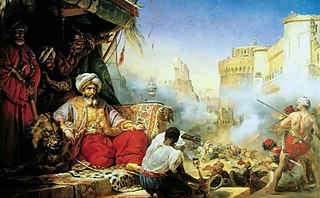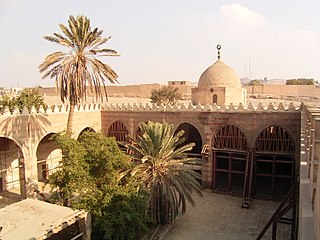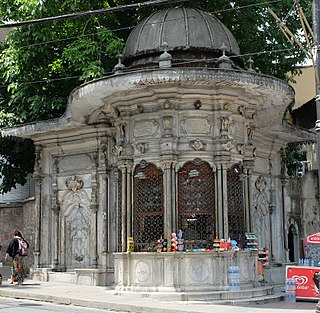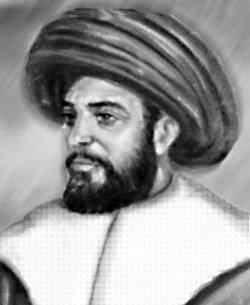
Cairo is the capital of Egypt and the largest city in the Arab world. The Greater Cairo metropolitan area, with a population of 21.3 million, is the largest urban agglomeration in Africa, the largest in the Arab world and the Middle East, and the sixth-largest in the world by population. Cairo is associated with ancient Egypt, as the Giza pyramid complex and the ancient cities of Memphis and Heliopolis are located in its geographical area. Located near the Nile Delta, the city first developed as Fustat, a settlement founded after the Muslim conquest of Egypt in 640 next to an existing ancient Roman fortress, Babylon. Under the Fatimid dynasty a new city, al-Qāhirah, was founded nearby in 969. It later superseded Fustat as the main urban centre during the Ayyubid and Mamluk periods. Cairo has long been a centre of the region's political and cultural life, and is titled "the city of a thousand minarets" for its preponderance of Islamic architecture. Cairo's historic center was awarded World Heritage Site-status in 1979. Cairo is considered a World City with a "Beta +" classification according to GaWC.

Muhammad Ali's seizure of power in Egypt came following a long, three-way civil war between the Ottoman Empire, Egyptian Mamluks who had ruled Egypt for centuries, and Albanian mercenaries in the service of the Ottomans. The conflict ended in victory for the Albanians led by Muhammad Ali of Egypt (1769–1849).

Haji Bektash Veli or Haji Bektash Wali was a Muslim mystic, saint, Sayyid and philosopher from Khorasan who lived and taught in Anatolia. He is revered among Alevis for an Islamic understanding that is esoteric (spiritual), rational, progressive, and humanistic. Alevi and Bektashi Muslims believe the path of Haji Bektash is the path of ʿAli ibn Abu Talib, since Ali was the source of Bektash's teachings. His original name was "Sayyid Muhammad ibn Sayyid Ibrāhim Ātā". He was one of the figures who flourished in the Sultanate of Rum and had an important influence on the Turkish nomads of Asia Minor. He is also referred to as the Sultan of Hearts and the Derwish of the Derwishes. Haji Bektash Veli was a descendant of Musa Kazim, the Seventh Imam of the Athnā‘ashariyyah Shi'a Muslim sect.

Tanta is a city in Egypt with the country's fifth largest populated area and 658,798 inhabitants as of 2018. Tanta is located between Cairo and Alexandria: 94 km (58 mi) north of Cairo and 130 km (81 mi) southeast of Alexandria. The capital of Gharbia Governorate, it is a center for the cotton-ginning industry. One of the major railway lines goes through Tanta. Annual festivals are held in Tanta for one week beginning on 11 October celebrating the birthday of Ahmad al-Badawi, a revered Sufi figure of the 13th century, who founded the Badawiyya Tariqa in Egypt and is buried in Ahmad Al-Badawi Mosque, the main mosque of Tanta. Tanta is known for its sweet shops and roasted chickpeas.

Aḥmad al-Badawī, also known as Al-Sayyid al-Badawī, or as al-Badawī for short, or reverentially as Shaykh al-Badawī by all those Sunni Muslims who venerate saints, was a 13th-century Moroccan Sunni Muslim mystic who became famous as the founder of the Badawiyyah order of Sufism. Originally hailing from Fes, al-Badawi eventually settled for good in Tanta, Egypt in 1236, whence he developed a posthumous reputation as "Egypt's greatest saint." As al-Badawi is perhaps "the most popular of Muslim saints in Egypt", his tomb has remained a "major site of visitation" for Muslims in the region.

Islamic Cairo, also called Historic Cairo or Medieval Cairo, refers generically to the historic areas of Cairo, Egypt, that existed before the city's modern expansion during the 19th and 20th centuries; particularly the central parts around the old walled city and around the Citadel of Cairo. The name "Islamic" Cairo refers not to a greater prominence of Muslims in the area but rather to the city's rich history and heritage since its foundation in the early period of Islam, while distinguishing it from with the nearby Ancient Egyptian sites of Giza and Memphis. This area holds one of the largest and densest concentrations of historic architecture in the Islamic world. It is characterized by hundreds of mosques, tombs, madrasas, mansions, caravanserais, and fortifications dating from throughout the Islamic era of Egypt. In 1979, the United Nations Educational, Scientific and Cultural Organization (UNESCO) proclaimed Historic Cairo a World Cultural Heritage site, as "one of the world's oldest Islamic cities, with its famous mosques, madrasas, hammams and fountains" and "the new centre of the Islamic world, reaching its golden age in the 14th century."

The Citadel of Cairo or Citadel of Saladin is a medieval Islamic-era fortification in Cairo, Egypt, built by Salah ad-Din (Saladin) and further developed by subsequent Egyptian rulers. It was the seat of government in Egypt and the residence of its rulers for nearly 700 years from the 13th to the 19th centuries. Its location on a promontory of the Mokattam hills near the center of Cairo commands a strategic position overlooking the city and dominating its skyline. At the time of its construction, it was among the most impressive and ambitious military fortification projects of its time. It is now a preserved historic site, including mosques and museums.

"Öküz" Mehmed Pasha, also known as Kara Mehmed Pasha or "Kul Kıran" Mehmed Pasha, was an Ottoman statesman, administrator and military figure of the early 17th century who held the office of Grand Vizier twice, the first time from 17 October 1614 to 17 November 1616 and the second time from 18 January 1619 to 23 December 1619. He was also governor of Egypt from 1607 to 1611. Okuz Mehmed's nickname "Kul Kiran" (slavebreaker) came from his success in crushing the mutiny in Egypt during the early 1600s.

Khan el-Khalili is a famous bazaar and souq in the historic center of Cairo, Egypt. Established as a center of trade in the Mamluk era and named for one of its several historic caravanserais, the bazaar district has since become one of Cairo's main attractions for tourists and Egyptians alike. It is also home to many Egyptian artisans and workshops involved in the production of traditional crafts and souvenirs. The name Khan el-Khalili historically referred to a single building in the area; today it refers to the entire shopping district.

Ahmad Pasha al-Jazzar was the Acre-based Ottoman governor of Sidon Eyalet from 1776 until his death in 1804 and the simultaneous governor of Damascus Eyalet in 1785–1786, 1790–1795, 1798–1799, and 1803–1804. A Bosnian of obscure origins, he began his military career in Egypt in the service of various Mamluk officials, eventually becoming a chief enforcer and assassin for Ali Bey al-Kabir, Egypt's practical ruler. He gained the epithet of al-Jazzar for his deadly ambush on a group of Bedouin tribesmen in retaliation for the death of his master in a Bedouin raid. Al-Jazzar fell out with Ali Bey in 1768 after refusing to take part in the assassination of one of his former masters. He ultimately fled to Syria, where he was tasked with defending Beirut from a joint assault by the Russian Navy and Zahir al-Umar, the Acre-based ruler of northern Palestine. He eventually surrendered and entered Zahir's service before defecting from him and fleeing with stolen tax money.

Desouki, also known as the Burhani order, is a Sufi order primarily found in Desouk in Egypt. It was founded by Ibrahim El-Desouki, whose resting place in the Nile delta is a major place of pilgrimage for Sufi Muslims from all over Egypt. Originally from Egypt, there is a significant population of memberes in Khartoum.

The Aqsunqur Mosque is located in Cairo, Egypt and is one of several "blue mosques" in the world. It is situated in the Tabbana Quarter in Islamic Cairo, between Bab Zuweila and the Citadel of Saladin The Aqsunqur Mosque also serves as a funerary complex, containing the mausoleums of its founder Shams ad-Din Aqsunqur, his sons, a number of children of the Bahri Mamluk sultan an-Nasir Muhammad and that of its principal restorer, Ibrahim Agha al-Mustahfizan.

Al-Azhar Mosque, known simply in Egypt as al-Azhar, is an Egyptian mosque in Islamic Cairo. Jawhar al-Siqilli commissioned its construction for the newly established capital city in 970. Its name is usually thought to derive from az-Zahrāʾ, a title given to Fatimah bent Muhammad, the Prophet of Islam. It was the first mosque established in Cairo, a city that has since gained the nickname "the City of a Thousand Minarets".

El-Sayyid el-Badawi Shehata is an Egyptian businessman and the President of Al-Wafd Party. He is the head of the Board of Directors of Al-Hayah Egyptian television network.

A sebil or sabil is a small kiosk in the Islamic architectural tradition where water is freely dispensed to members of the public by an attendant behind a grilled window. The term is sometimes also used to refer to simple unmanned fountains with a tap for drinking water, though other names often exist for such fountains.

'Ibrahīm Bin ʿAbd-El-ʿAzīz 'Abu al-Magd, better known as El Desouki (الدسوقي), was an Egyptian Imam and the founder of the Desouki Order.

Shuhada is a city and corresponding markaz in Monufia Governorate, Egypt. As of 2019, its estimated population is 358,486, with 72,895 people living in urban areas and 285,591 living in rural areas.

Elsayyed ElBadawi Mosque is the largest mosque in the northern city of Tanta, Egypt. It is a Sunni Sufi mosque and contains the tomb of Ahmad al-Badawi.

Umar Makram bin Hussien al-Sayouti (1750-1822) was an Egyptian political leader at the time of the 1798 French invasion and in the subsequent political disorders.

Shah Muhammad Ali Hisâm-ad-Dîn Naqshbandî also known as Hâzrat-i Shâh and Bâbâ Ali was a 19th-century sufi, awliya' and Islamic scholar born in Tawella village which was part of Ottoman Empire lands at that time. He is sayyid and sherif also revindicated as an ancestor of Sayyid Battal Gazi. Muhammad Ali Hisâm-ad-Dîn is the grandson of Uthman Sirâj-ud-Dîn Naqshbandi of Tawella who is the first caliph of Mawlânâ Khâlid al-Baghdadî in Sulaymaniyah.



















